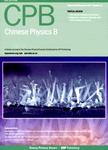Control water molecules across carbon-based nanochannels
Control water molecules across carbon-based nanochannels作者机构:School of Physics China University of Mining and Technology Department of Physics Fudan University State Key Laboratory of Surface Physics Fudan University
出 版 物:《Chinese Physics B》 (中国物理B(英文版))
年 卷 期:2018年第27卷第1期
页 面:127-135页
核心收录:
学科分类:07[理学] 0805[工学-材料科学与工程(可授工学、理学学位)] 0704[理学-天文学] 0702[理学-物理学]
基 金:Project supported by the Fundamental Research Funds for the Central Universities of China(Grant No.2015QNA48) the Natural Science Foundation of Jiangsu Province,China(Grant No.BK20150173) the Science and Technology Commission of Shanghai Municipality,China(Grant No.16ZR1445100) the National Natural Science Foudnation of China(Grant Nos.11725521 and 11605285)
主 题:carbon nanotube water molecules flow enhancement confinement
摘 要:It is important to know the mechanisms of water molecules across carbon-based nanochannels, which is not only beneficial for understanding biological activities but also for designing various smart devices. Here we review the recent progress of research tbr water transfer across carbon-based nanochannels. In this review, we summarize the recent methods which can affect water molecules across these nanochannels. The methods include exterior factors (i.e., dipolar molecules and gradient electric fields) and interior factors (namely, cone-shaped structures, nonstraight nanochannels, and channel defects). These factors can control water permeation across nanochannels efficiently.



